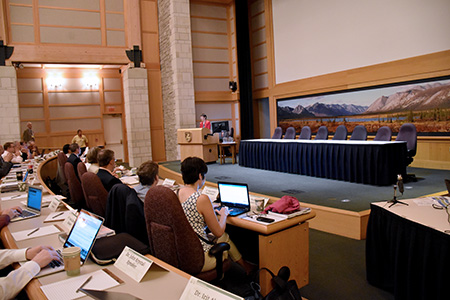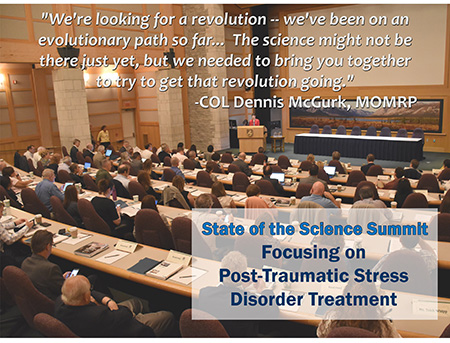Teaming Up to Seek Treatments for PTSD


At the National Conservation Training Center in Shepherdstown, West Virginia, more than 130 leading researchers in the field of post-traumatic stress disorder came together for a State of the Science Summit to investigate new and current avenues in drug development to fight PTSD and its related problems, June 13-14. Entitled "Pathophysiology of Post-Traumatic Stress Disorder: Rethinking Drug Targets," the two-day meeting was co-hosted by the U.S. Army Medical Materiel Development Activity's Neurotrauma and Psychological Health Project Management Office, and the Joint Program Committee/Military Operational Medicine Research Program of the Department of Defense.
Maj. Gen. Barbara R. Holcomb, commanding general of the U.S. Army Medical Research and Materiel Command and Fort Detrick, Maryland, opened the day's session and welcomed the invited experts from government, industry and academia.
"Your attendance and participation demonstrates your commitment to providing the best solutions for our Nation's Warfighters," said Holcomb. "PTSD has a great impact on the readiness of our military forces, and preventing, diagnosing and treating victims of PTSD remains one of the highest priorities of the Department of Defense."
In her speech, Holcomb said that PTSD has become a household term over the past decade, and that, as a country, we have grown in our awareness of this important health issue. She stated that throughout the DOD, there have been more than 210,000 instances of PTSD since the year 2000, and it is now one of the most common major mental health conditions that occur as a result of combat experience – second only to depression.
"This summit is an opportunity to streamline and accelerate progress in the development of PTSD treatments, and facilitate collaboration among DOD federal agencies, academia, industry and non-profit organizations," Holcomb said.
"While we have made good progress, we certainly have a way to go," she continued. "I look forward to the discussions and outcomes that result from this summit."
Col. Dennis McGurk, program area director for USAMRMC's Military Operational Medicine Research Program, followed the introductions and helped to set the tone for the meeting with his presentation, "Sharing the Vision," in which he provided an overview of the USAMRMC and its work in PTSD research.
"Since 1987, the DOD has actively pursued answers [for treatment of PTSD]," he said. "We have not been waiting until this meeting to figure out the pathophysiology of PTSD. Our senior leaders do not want to wait to help take care of our Service Members – we must take care of them now.
"But we're looking for a revolution – we've been on an evolutionary path so far, and it's slow. The science might not be there just yet, but we needed to bring you together to try to get that revolution going."
In setting the stage for the summit, McGurk explained that the intent of the organizers was to create a forum for open discussion that could help prompt critical thinking "outside of the box" by the attendees.
"We are hoping that you will challenge each other during this meeting," he said. "We need to find a way to streamline the process to reach the answers we're looking for."
McGurk's cogent presentation seemed to motivate the group, and he conveyed information on the potential funding opportunities available through the DOD for PTSD research. He clarified that the end goal of funding is to produce a U.S. Food and Drug Administration-approved, safe, effective, militarily relevant, affordable and sustainable fielded product. Understandably, this product would be used in the treatment of patients suffering from PTSD.
Following the introductory presentations, nearly two dozen speakers offered insight regarding the state of PTSD research and treatment. The topics of these reports included establishing partnerships in drug development for PTSD treatment; research collaborations involving academia, government and private industry; investigating PTSD biomarkers; and emerging concepts in brain functioning related to PTSD.
At mid-morning on the second day of the summit, the participants were divided into 10 small working groups, and all were asked to share information and ideas to address six specific questions regarding PTSD research and treatment. Each working group was led by a member of the Expert Panel group, who was responsible for providing a summary of the group's discussion and key points during the final plenary session.
Attendance and active participation during the working group session was mandatory for all invited guests who were subject matter experts, as the main focus of the activity was to explore viable options for drug development, and to make informed recommendations on a path forward towards effective treatment of PTSD.
In addition to the breakout sessions and plenary presentations offered over the two-day summit, 20 poster abstracts selected from a variety of submissions were placed on display in the Roosevelt Room of the NCTC. Guests of the conference were able to browse the hall to examine the gallery of work dedicated to the topic of PTSD research.
Col. William E. Geesey, USAMMDA commander, said that the NPH PMO and MOMRP teams have been working very diligently towards the success of this week's summit, and he remains very clear on the significance of research in this critical field.
"It was important to assemble these subject matter experts and stakeholders from across the globe, so we can advance the research in this very important area of PTSD," said Geesey. "This initiative can help to develop drugs that will not only benefit Warfighters but other service workers, such as police officers and firemen, who sometimes may be exposed to traumatic situations."
"It's exciting to see the progress that we're poised to make in this area," he added.
The interaction of the participants during the summit is intended to generate information regarding PTSD that may help to identify the most promising new drug targets for treatment of this serious condition.
"Through this State of the Science Summit," said McGurk, "we hope to provide an opportunity for industry, academia, and government to problem-solve with one another, and initiate viable partnerships for future efforts."
Without question, "hope" certainly remains a key factor for those involved in this critical endeavor.













